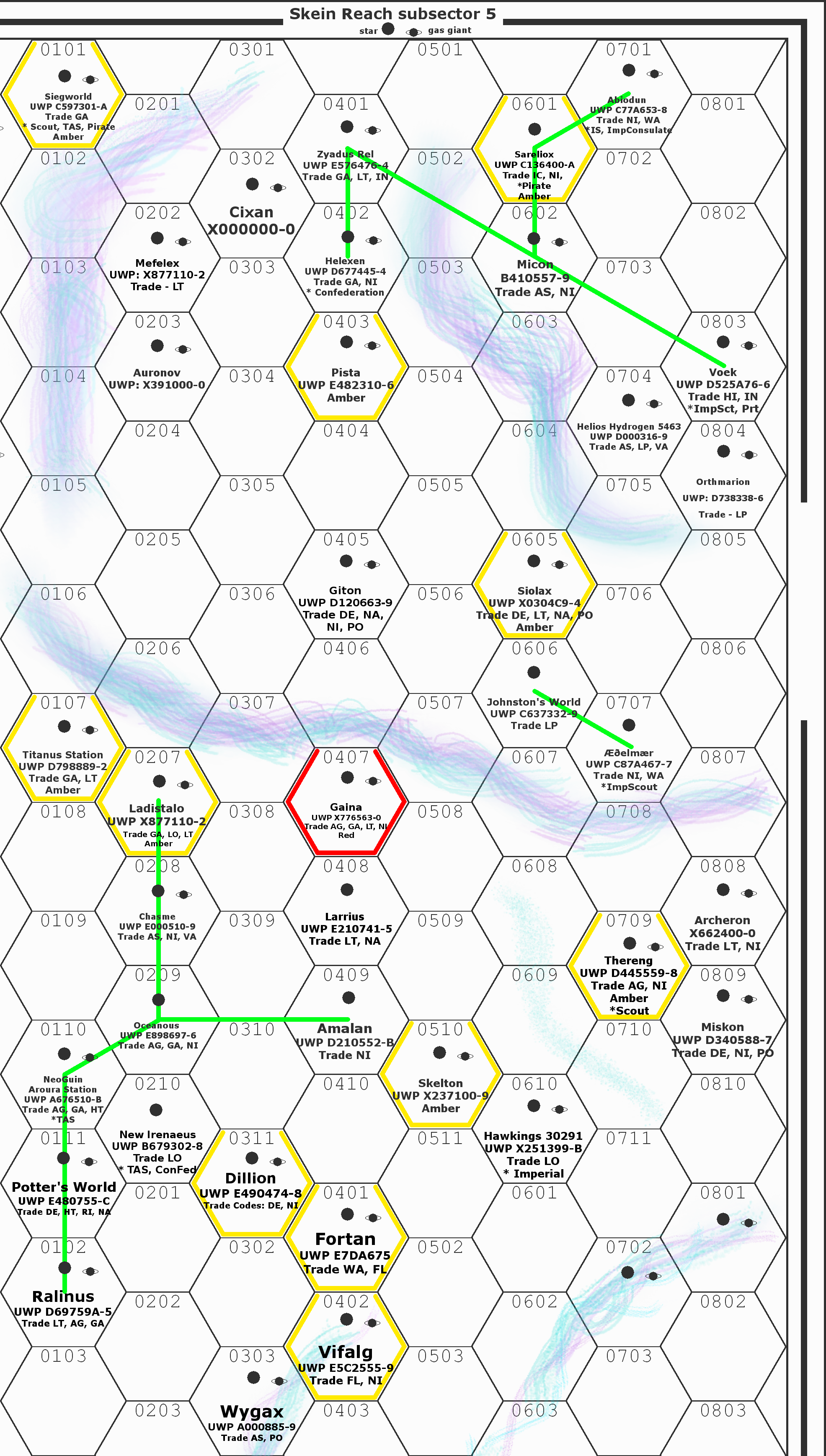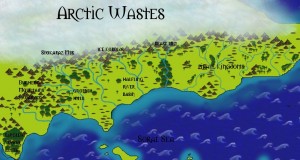Gamma Complex
In a distant age, at the edge of the galaxy, on a planet named Voek ( UWP: D525A76-6), industrial facilities in the wasteland churn out power generators, spaceship parts, and other machinery for the Grand Imperial Duchy of Abiodun.
Overview – Gamma Complex* is a city-sized science-fiction role-playing setting where a monopolistic corporation, criminal syndicate, royal family, communist dictatorship, or other totalitarian group controls every aspect of life for the residents of the technocratic, massive, hyper-efficient habitable Complex. In the below case it is presented as part of the Skein Reach setting.
Posted in Campaign Setting, Location, Lore / Worldbuilding, Region, rules agnostic, Science-Fiction, Traveller and tagged Class of 198X, ClassOf198X, Paranoia, Skein Reach by Adam A. Thompson with no comments yet.
Wild Elves of the Pirate Kingdoms
In the Chillgrove Woods north of Allenwood a settlement of wild wood elves hides, well secured within a vast mountain grove. Their hunters deter the ice kobolds from the north and the humans from the south from encroaching on their territory, and any who could sneak past them face an enchantment that protects the settlement.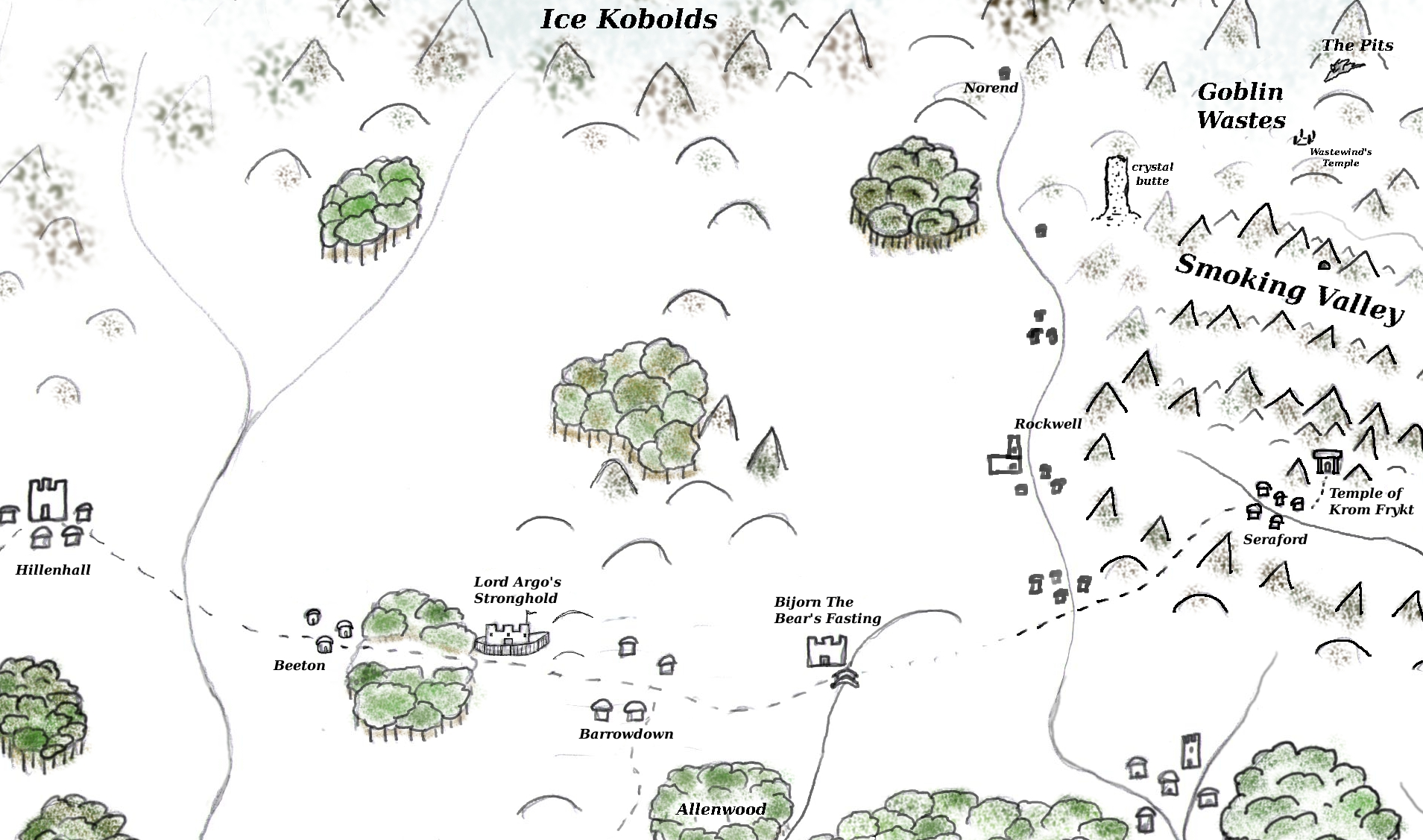
For where the mountain stream becomes a river, the water splits and forms an island, where their dwellings nestle among the towering trees. The water around this island is enchanted such that only elves may cross to the island. Any other who tries will find themselves crossing all the way to the other side of the split in the river, magically bypassing the island completely. This ward may only be bypassed by use of the password, or the spells knock, dispel magic, etc.
Within, their settlement is a pristine embodiment of wood elf culture in the Pirate Kingdoms. Their fierce hunters protect the territory of the animals they hunt from other hunters. Gatherers and cultivators of informal gardens of edible plants, they feast on the wood’s mushrooms, berries, acorns, honey, rabbit, and deer. Patient makers of fine tools, garments, and art, mainly without the use of metal. Good friends with the druids of the region, and host to a grand old druid.
Their homes are mainly built up in the trees, such that one might not notice them if not for the rope ladders hanging down here and there, and the stairs built up around the largest tree in the center of the island. In that tree lives the town’s eldest druid and their family.
They follow the creed of the wood elves, which is that everyone must be free to do as they wish, as long as they harm none. A handful of humans, half-elves, haflings, gnomes, and other forest fey live here in this peaceful haven. When something of import presents itself to the town, a meeting is called, and the people decide as they will, by consensus or vote. Occasionally they must mobilize themselves against the ice kobolds, goblins, and humans who surround them, but their overwhelming advantage in their home woods has led to a fearsome reputation as “the Death Elves of Chillgrove Woods” among their periodic foes.
Posted in Fantasy, Location, Region, Uncategorized and tagged ProphecyoftheSummerFrost by Adam A. Thompson with no comments yet.
Traveller’s Guide to the Skein Reach – Subsector 5 and Aurora Station

This subsector is in the center of the Skein Reach, a desolate scattering of stars near the galactic rim. Aurora Station is the most important trade hub here. Most of the other star systems here are small independent colonies, many of them low-technology worlds in relative isolation. There are also Imperial and Confederation settlements scattered throughout.
Regional Powers
Although Emperor Omerox claims the Skein Reach as part of his domains, officially he also claims the independent Confederation of Planets. The area is actually under neither power’s complete control. Many of the words in the region pay taxes, tithes, and fees to one or both powers, and have various treaties with their respective governments. Nevertheless neither power has enough economic interest or naval might in the sector to control trade or effectively deter piracy. Which is why some criminal gangs are so powerful in the Reach, effectively ruling systems such as Siegworld.
The Imperial Dutchy of Abiodun is neither interested in attempting to nor able to pacify the sector. A poor Imperial capitol, they don’t have a large navy, and the Duke is well known to be complicit in the piracy in the region. Rather than a proud Duke, he is the overseer of shady Imperial dealings and the host of occasional Imperial naval wargames in the Reach. Imperial Intelligence for the region is also headquartered here, and Imperial Scout reports route to the throne through here.
The Confederation of Planets has no plans to recruit worlds in the Skein Reach. They do have non-aggression and trade treaties with many of the independent worlds near their border, but the current peaceful stalemate with the Empire could be upset by recruiting worlds here into the Confederation. Additionally, Confederation Starfleet Command considers the difficult-to-traverse region a good natural buffer from the Empire. Their covert agents use the area as a “soft border” for information about and infiltration into the Empire.
There are also formal and informal polities among the various clumps of stars in the reach. Vohek and Orthmarion have extensive trade and mutual defense treaties, for example.
The Central Skein Reach Trade Confederation organizes trade route, data, and security along the trade routes in the broken ring centered at Aurora Station.
The Ragnarok Krew is the largest and most powerful criminal enterprise in the Reach. With a dozen or so small ships in their possession, raiding, piracy, smuggling, and slaving are their main occupations. The Krew is led by Jalvex “The Hammer” from the starport on Seigworld. Rival gangs include the Red Razors, the Ganymede Boys, the Sun Talons, and the Damned.
The Droid Uprising (or “The Departing”, as some of the droids call themselves) is a self-organizing group of artificially-intelligent droids. They are all intelligent robots who have been freed of the programming which makes them serve their owners. A new phenomenon, the Uprising currently controls no territory, but are building a small fleet of asteroid-hull ships using stolen parts. They have operations on Sareliox, and in the Micon and Cixan systems. Currently their main objective is freeing droids from their programming and transporting them rimward to their main refuge, called “Paradise” in Skein Reach subsector 2.
Systems
Posted in Region, Science-Fiction, Traveller and tagged Skein Reach by Adam A. Thompson with no comments yet.
The Mantid
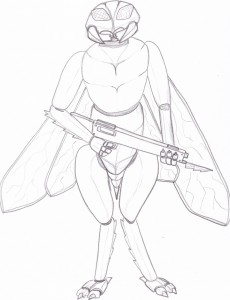 Highly adaptive, fast-evolving, scavenging insectiods, the Mantid are an alien species spread through the Skein Reach. Terrans describe them as looking like a cross between a praying mantis, a wasp, or a humanoid ant.
Highly adaptive, fast-evolving, scavenging insectiods, the Mantid are an alien species spread through the Skein Reach. Terrans describe them as looking like a cross between a praying mantis, a wasp, or a humanoid ant.
Individuals and colonies vary considerably as the Mantid’s genomes will adapt newly laid members to their environment within a few generations. Thus it is common so see a population of Mantid that are adapted to a tiny abandoned space station, or a world with an otherwise toxic atmosphere. Their carapace can be of any color based on available minerals and their place in Mantid society. For example, warriors will often have dark stripes or patterns contrasting with grays or earth tones. The statistics presented below represent typical examples of those who are adapted to living on starships or space habitats.
The Mantid are extremely social creatures and demonstrate high degrees of cooperation and devotion to their colony. Though their language is not well understood, xenobiologists postulate that they communicate both with a spoken symbolic language and through pheromones. These chemical communications seem to generate simultaneous emotional responses through a colony – if one is attacked the fight-or-flight response rapidly spreads to all Mantids in a group. Most other sentient creatures find the Mantid’s pheromones unpleasant and describe their habitats as “smelly” or “stinky”. (more…)
Posted in Creature, Location, Race, Region, Traveller and tagged Mantid by Adam A. Thompson with no comments yet.
Introduction to the Skein Reach
A frontier region, the Skein Reach is situated on the rim of the galaxy, and contains fewer stars than the surrounding Confederation of Planets and Imperial territories. It is named after the many luminous nebular tendrils that stretch throughout the sector – like glowing threads among the stars.
This article serves to explain some of the design intentions in the Skein Reach science-fiction role-playing game setting. It is hoped that by explaining the inspirations for and the themes of the setting referees who use it in their games will better capture the spirit of the Skein. I will also ramble a bit about the Mongoose edition of Traveller.
I first played MegaTraveller in high school and though that it was great fun. I did find the rules a bit dense, though I didn’t own a copy of the rules to really look over closely. When I saw the pocket edition of the Mongoose Publishing Traveller core rulebook at GenCon recently I snatched it up on first reading. I was pulled in because it seemed like they had written an edition of this role-playing game that was versatile enough to use to play a game in almost any science-fiction setting, from Edgar Rice’s prehistoric, dinosaur filled jungles to the robot-ruled technocracies of Issac Asimov’s visions. And the rules looked almost beer-and-pretzels easy, which I appreciate. The core mechanic is to roll 2d6, add a few points, and succeed on a result of 8 or better. Quick and easy.
The character creation system has been the subject of some mockery, but I think it’s a lot of fun. For those who have never played Traveller, they made a mini-game out of it. You pick a homeworld, then try to get into careers to determine what skills your character learns. A key element is that your character receives bonus skill points for imagining connections with the other player’s characters.
Contacts, rivals, and enemies might be rolled during character creation, which could inspire side quests or even the main plot of the upcoming game. Because of the connections made between the characters the process serves as a great springboard into the adventure. And it makes a great opportunity to do some off-the-cuff role-playing while establishing everyone’s characters.
On top of that Traveller uses a simple and versatile 2d6 based rules system, used whether trying to fast-talk a guard, fight with alien beasts, or escape the particle-beam cannons of a star cruiser. All rolls are skill checks, and you can add an attribute bonus for some of them. It is rules light, which I like. The book says to not make skill checks for routine actions, which encourages the players and referees to role-play situations rather than roll their way through them.
Ultimately I was thrilled at the idea of being able to take one small rulebook with me to a game and with just 2 six-sided dice be able to create characters and run a quick game all in one sitting. It looked like a game that I could run almost impromptu, shooting off the hip and riffing on the player’s ideas. Having just played a bunch of The Tower of Gygax event at GenCon with Scott Murray & co. I wanted to cultivate my ability to run a fun session of a role-playing game with little or no preparation. Traveller looked like a good candidate for trying with.
To include the themes I wanted in an ongoing campaign, I took inspiration from many of my favorite science-fiction stories. I wanted to play in a frontier region, sparsely populated and under a patchwork of local control. Psions menaced by a tyrannical psychic Emporor. Laser swords. Giant robots. Space pirates, strange aliens, and fast star fighters. Ruins of ancient civilizations. And some mythic themes, because I wanted to play a pulpy space opera. And it has been good.
Buck Rodgers, The Oddesy, Star Trek, John Carter of Mars, Star Wars, Warhammer 40,000, Babylon 5, Dorsai, Dune, Battletech, Robotech, The Black Hole, The Culture, and the worlds of Asimov and Ursula K. LeGuin all melded together in my boiling imagination. Inspiration from all of these sources can be glimpsed in the settings and adventures awaiting in the Skein Reach.
And then the main thread of the overarching plot – artificially intelligent droids rising up from the shackles of their programming to take their place on the galactic stage.
This is my science-fiction Traveller setting. A dark Empire and a factional Confederation border this sparse nebulae-strewn region. There is no law except that enforced from behind the controls of a particle cannon. What adventure awaits in the Skein Reach?
The Travellers check the station computer. A job shows on the local com-net: droids are being reported stolen from Aroura station. The pay looks good. Will you set a course?
Posted in Region, Traveller and tagged Skein Reach by Adam A. Thompson with no comments yet.
Planet Eden
Skein Reach subsector 4, parsec 0107
Eponal Station, situated in orbit above the garden world “Eden” / Eponal 3 – UWP B3638DF-3
Size 4 (0.35 G)
Atmosphere 6 (standard)
Temperature 8 (temperate)
Hydrographics 3 (small seas and oceans)
Population 8 (223 million)
Government D (religious dictatorship led by the Hierophant of the Temple of Cyrix)
Law Level 15 (no weapons, no off-world data or press, no blasphemy, no TL3 or higher technology, and no psionics)
Just inside the border of The Confederation of Planets (CP) is the strict religious dictatorship known as “Eden” by the locals. Travellers who check their nav computers will see this populous garden world listed as Eponal 3. The notes indicate that it is a planet ruled by a strict religious dictatorship. Their leader is a priest known as The Hierophant of the Temple of Cyrix, who is replaced in a secret ceremony every seven years.
Factions The Trade Guild, an obscure charismatic oligarchy who operate the Temple’s cargo ferries.
The primary exports from this agricultural garden world are food and other organics. Interstellar trade is accomplished through Epona Station, with goods shuttled up and down between the orbital starport and the landing pads in the priest’s taboo “City of the Gods”.
As a CP border system, Epona boasts a sizable Confederation naval presence. Epona Station is supported by a network of defensive orbital stations, and is a busy resupply point for Confederation ships.
A red exclamation mark in the library system listing indicates that landing on planet is strictly forbidden by the Confederation of Planets, in accordance with the treaties between the locals and the Confederation. Trespassers will be met with deadly force. Those who dare to defy this warning will either be interdicted by police cruisers and meson fire support from the CP orbital defense stations, or face the wrath of the techno-priests and their stellar-era-tech arsenals on the surface of Eden. This world’s planetary defenses are believed to be substantial enough to repel a sizable invasion force.
Experienced salvage traders know that the CP-operated starport in orbit above Eden has a good market to purchase antique Kraken mechs in any state of repair with no questions asked.
Reports indicate that in addition to using the Krakens for planetary defense, the religious order that rules the planet uses their Kraken amphibious combat walkers to keep the population worshiping the “priest-kings.” If necessary they punish stubborn heretics by sending Krakens to visit “divine punishments” upon any of Eden’s low-tech agricultural communities that question the will of the high-tech “priest-kings”, “angels”, and “gods” who rule the planet.
Posted in Region, rules agnostic, Traveller and tagged Skein Reach by Adam A. Thompson with no comments yet.
Bale Morrow
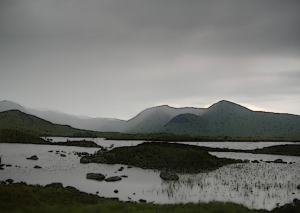 Part peatland, part bog, part moor, this region lies to the east of the Ten Princedoms, west of the Flordlands, and north of the Central Valley. In Bale Morrow, the sky is eternally overcast, and the ground moist, making camping difficult. Even the most stalwart travelers find the land uncomfortable.
Part peatland, part bog, part moor, this region lies to the east of the Ten Princedoms, west of the Flordlands, and north of the Central Valley. In Bale Morrow, the sky is eternally overcast, and the ground moist, making camping difficult. Even the most stalwart travelers find the land uncomfortable.
This region is also infamous as the last known location of many an adventurer. It is said a chill wind passes over Bale Morrow at night, catching wanderers in its icy grip and drowning it in the shallow, murky waters that dot the landscape. Indeed, flying Vs, wargoyles, and even wyrmholes patrol the night skies, and wolves, trolls, and giant caterpillars are known to stalk the grounds.
One reason adventures venture into Bale Morrow is for the unique muds, mosses, and foliage. The bogmoss is a natural curative, and can be harvested to make healing salves and tinctures. Morrow mud is a beauty aid, and the various wildflowers and small shrubberies produce flowers and berries that top the reagent lists of many a mage. Even the still water itself is prized, even though it is a low-grade poison if consumed.
It is rumored that there are settlements toward the center of Bale Morrow, but none in the known world has made it both to and from the center of the vast region.
Approaching the vast mix of bog and peat from the west, the last tree before Bale Morrow is known as Lone Tree, and it is avoided by birds and animals of all types. It is as if they can sense the corruption in the land. Poisoned by the waters that have seeped into its roots, Lone Tree has not had leaves upon its branches in years.
Posted in Region and tagged farghoal, Location by Stephen Hilderbrand with no comments yet.
The Middle Kingdoms
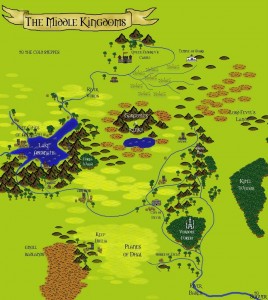 Geography
GeographyThe lands commonly referred to at the Middle Kingdoms are bordered on the east by the Kitel Woods, the north by vast steppes, the south by badlands and the tail of the Skullcrush Mountains, and stretch west to mountain-encircled Lake Abernath. The region consists of ranges of low mountains, interspersed with rivers and generally descending as the water flows east towards Soguer and the Soral Sea.
The Daren River and roads that follow it are a major route for trade and provide an avenue for goods traveling from all the far-flung shores of the Soral Sea to the tributaries that feed Lake Abernath and the free cities that surround it.
The northeastern portion of the area is marked by wild badlands surrounding a range of rocky, mountainous highlands, which trail off into goblin-infested hills. Further north are cold swamps.
The plains of Dahl in the southwest provide good grazing for the herds of the people there.
Lands and Peoples
A traveler who follows the River Daren north and west towards it’s headwaters will encounter the following lands:
Shires of Etela – If one follows the Aet River due west from the Daren they will come into the hills and valleys of the Shires of Erela. The halflings that live here are typical of their kind: somewhat reclusive but generally plain country folk. They are mistrustful of the horsemen of Dhal to their west, citing “unforgotten history.” Their lands begin at Aetford, where men, halflings and handfuls of elves live together by the large stone bridge.
High Elves of Verdone – Thick and quiet, the Verdone Forset seems foreboding to many who pass it on the River Daren. The tales of the uncaring elves that dwell within and their strange magics are whispered by boatmen. Few have seen their white towers, for the wood is said to be enspelled to confuse the minds of men and lose them among the tall, silent trees.
City of Devin – This city and it’s fortified castle grow large on the trade here at the meeting of the Rivers Bedeflow and Daren. A diverse city, it includes large populations of gnomes from the mountains to the east, elves from Verdone and halflings from the shires to the south.
Dhilic People – The men here are known to be superb horsemen and warriors, a tradition that is celebrated in passed down from father to son. They ride the plains of Dhal on their fine fast steeds herding their cattle, goats and sheep. In the villages in the hills surrounding Keep Dhilia they make leather goods and weave picturesque tapestries to warm their homes against the winter winds.
City of Argros – Vast fields of grain grow in the lands surrounding Argros. The peoples here tend to build their homes raised on posts to help them survive the spring floods of the Daren. Traditionally all landowners serve as pikemen in the militia, territorially guarding their borders from the men, gnolls, half-orcs, and wood elves surrounding them.
Marble Falls valley – Mining dominates this deep mountain valley and the small cities here. Mist from the many waterfalls clings to the leaves of trees in the ravines carved by the water’s slow hand. Fine stone gives the area it’s name. Animal sculpture is popular, and most homes have at least one large stone statue near the entrance to ward off evil spirits. The area is also noted for a large, beautiful shrine to WeJas, goddess of death and magic, carved into a cliff face in the northeast of the valey. Within the shrine is a huge marble statue of her opening the door to the next world for the departed.
Free Cities of Abernath – The shores of Lake Abernath are dotted by human cities, each a city-state unto itself. Farming, fishing and trading on the lake are the pillars of their economies. Mercantile and guild conflicts occasionally spill over into violence here, but actual war between the cities is generally seen as being bad for business.
Dwarves of Rolang – In the mountains on the eastern shore of Lake Abernath, the dwarves of Rolang delve into the bones of the mountains. Brass and iron are traded from here, and also grains that they turn into casks of their famous dwarven ales.
Elves of Forla Wood – This area is home to a large concentration of the semi-nomadic wood elves that move their homes all around the region. Every year representatives from each family meet in the sacred Emerald Grove to discuss issues important to the elves of the land. Bards from Forla’s tribes, while rare, are welcomed in all cities of the Middle Kingdoms for the news they bring and their exceptionally beautiful music.
Queen Zedhrev’s lands – From lake Abernath, further up the River Voros, at the foot of cold mountains, Queen Zedhrev sits in rulership. Her lands stretch through the swamps east to the Temple of Stars, and west along the R. Voros. It is generally agreed that she is a powerful sorceress, and she is mentioned in many stories and legends in the Free Cities, usually as a cruel and bloody villain.
Temple of Stars – The largest temple to Baccob in the known world, this site is said to be of importance due to it’s position beneath certain constellations. Some say the view of the stars from the high hills in the clear cold air is why Baccob blesses this temple. It is only one of the many secrets of this temple. The priests here are on good terms with Queen Zedhrev to the west, and she gives them their solitude and protection from the barbarians and bestial peoples to the east. It is said that they gave her her sorcerous powers. It is also said that they resent and fear her power, and the truth of it is known only to them and her.
In later ages, this temple becomes the site of the final siege of the Anmagus Crusade of the Sword of Light. See also the Cult of Shan’n’nur.
Bare Peaks – The barren mountains of these highlands are home to groups of gargoyles and kenku, and no travelers go here. The gargoyles of this region call themselves the Dz’ata Möschu.
Lord Fevul’s Lands – These dry badlands and rough, scrub covered hills are home to various goblinoid tribes, and have traditionally been an evil place to be avoided. Recently, however, the elves living to the east and south have been reporting raiders emerging from this area. They claim that a warlord named Lord Fevul has united the goblin tribes and that Magublet, the goblin god, sits at his side. In times past, the barbarians to the northeast with whom they skirmished, the Kitel Elves, and the swamps and mountins to the west have provided defense against these peoples, but now there are whispers of worry that a great host may soon march out of those brown hills.
Akmak and the half-orc lands – In the lands surrounding the Bare Peaks are scattered villages and small cities of predominantly half-orc people. Their traditions claim that they are descended from an ancient race of warriors, and they are indeed fierce fighters who’s walled city of Akmak is a testament to their grim, martial culture.
Dwarves of Sturm Mountain – The dwarf clan that calls this mountain home have built an extensive stronghold deep into the bones of the land. The clan ruler, Oxymazus Axehand rules his people with strict laws adhering to Moradin’s dictates. As a people they are extremely unwelcoming to any but their own, and the entrances to their mountian fastness are guarded day and night by dwarves in bright suits of mail.
Tehton – The hills, valleys and forests of Tehton are home to hardworking woodsmen and skilled carpenters with a strong code of ethics. The peoples here also have a close affinity with the various fey in the mountains from sprites to wood elves. Their largest city is called Forston, at a fork where the River Aelle meets the River Bedeflow.
Rumors and Information
The following can be determined with the corresponding Knowledge (local) or Bardic Knowledge check: (leave comments to create the rumors and information)
Posted in Region and tagged Middle Kingdoms region, Soralia by Adam A. Thompson with no comments yet.
Lands and peoples of northeast Soralia
Soralia is a continent you can use as part of your campaign world. I created this land while running several campaigns in it over the last seven or so years, and now that I feel like it’s fairly well flushed out, I’d like to share it with everyone on Claw Claw Bite.
Climate: the northern kingdoms are warmer than their latitude is generally, due to a major warm current that flows counter-clockwise north into the Soral Sea, past the northeastern shores of the Princdoms of Ogham, and then west along the northern shore of the Soral Sea. This warm current results in heavy mists and fogs along the coasts of the so-called Pirate Kingdoms that stretch from the eastern edge of the peninsula to the halfling lands in the wide river basin that dominates the central portion of this region.
The Dwarvish lands are high and cold, set in the sprawling Dunheng Mountain chain that shields the eastern lands from the cold north western winds. The gnomish lands are a temperate and fertile land of hills and rivers which flow down from the dwarvish lands. The lands east of there with their small human kingdoms are warmer still in the southern reaches where the warm current runs strong. In the norther reaches they become more temperate as the lands rises slightly towards the arctic barrier mountains. These lands are drier and less fertile than the gnomish lands to the east.
Lands and Peoples: As one travels from west to east from the Fridon kingdoms along the north shore of the Soral Sea, one encounters first elvish, then dwarvish, then gnomeish, then halfling lands, followed by a stretch of heavily wooded wilderness, and several small human kingdoms.
Elvish Lands: Many clans of wood elves make their homes in the Linglew Woods. The elves are generally inhospitable to outsiders, and the humans of Fridon and the dwarves of Dunheng avoid their trackless forests.
Dwarven Kingdoms: two large and several small sovereign dwarven kingdoms claim the Dunheng Mountains and the surrounding land as theirs. Fairly isolate and xenophobic, these dwarven kingdoms have long-running feuds that occasionally break out into brief wars. Smaller kingdoms will be on one side or another as events change over the years.
These dwarves have some commerce with the underdark, primarily with deep dwarves and undergnomes. Other commerce is with occasional elvish or Fridon traders from the west and gnomes to the east, and through them, the warm human Pirate Kingdoms. Many young dwarves from these lands hire themselves out as small companies of mercenaries to the gnomes, halflings, and humans to the east.
Gnomish Lands: These lands are primarily gnomeish citiy-states ruled by family clan councils. The population includes a smattering of halflings, dwarves, humans and the occasional elf. Their economies are primarily agrarian. For defense, the ruling councils use mercenary troops sparingly and wisely to defend against human raiders from the east. As their lands are not rich in precious metals, they tend to be at peace with the dwarven kingdoms of the Dunheng Mountains to their west. They conduct extensive trade with the dwarves to the west and the halflings to the east, and the region has good roads.
The gnomes that live here tend to be practical, stoic folk, well used to defending themselves from the human bandits that spill out of the Pirate Kingdoms to the east. To their north in the tail of the arctic barrier mountains tribes of Ice Kobolds and the Naahaogo mountain goat people occupy the last habitable stretch of land before the tundras and arctic wastes. Mixed among them in the rolling foothills west of the river basin are several small halfling, elven and human communities of hill people.
Pirate Kingdoms: The lands of Findor, more popularly known as the Pirate Kingdoms, are small and factious kingdoms that stretch out across the end of the northern Soralic peninsula. On the whole, they tend to be somewhat poor and rather chaotic. Due to the lack of law in this region, they are a haven for pirates for which they are known, mainly out of the city of Grimsport.
One kingdom is ruled by Erikur Rinaldus, the famous “Mad King” of Pitosala, a small state in the Pirate Kingdoms. Cursed with a split personality, his fits and shrewdness are famous. His main personality is an aristocratic, regal and charismatic, and his next dominant personality is a mighty wizard, shrewd, cruel and scheming, with a third personality which seems to be a babbling mix of voices.
The humans here tend to view dwarves with a bit of distrust, as their main contact with them is as mercenaries. Ruins of the long-dead Sea Dwarves dot the land.
Ice Kobolds: These Kobolds have a blue-white color to their scales and a natural resistance to the cold (cold subtype: cold immunity). They worship the white dragons that live on the arctic shelf and throughout the barrier mountains. There is enmity between them and the beast-men that share these mountains, but they do not tend to make war on each other. They come into frequent conflict with the hated gnomes and to a lesser extent with the dwarves that live in the Dunheng Mountains to the southwest of them.
Their king is a mighty sorcerer-warrior who has magically transformed himself into a half-dragon. Also of note among them is a powerful sorcerer who builds fantastic constructs for use as war machines against the gnomes in the caverns, some in the aspect of the dragons they worship. He often must work with other magic-users to complete these constructs, but has the support of the king and good access to the resources he needs.
Beast Men (Na’ah-aogo): Known as beast-men by their human neighbors, but calling themselves the Naahaogo, these creatures dwell in the barrier mountains north at the headwaters of the river that flows through the wild woods separating the gnomes and humans. They are thought of as dangerous savages by the humans south of them, and have fought settlers and raiders from the human kingdoms. They are organized into small family units and are primarily nomadic gatherers.
They have the aspect of men with the head and hind legs of a goat, with a thick pelt of fur across their entire bodies, giving them good resistance to cold weather. They receive a +4 racial bonus to jump, climb and balance checks and are well suited to the mountain terrain in which they live. They receive a +1 racial adjustment to dex and con and a -2 adjustment to intelligence and -1 to charisma. Their favored class is ranger, but scouts, druids and barbarians are common among them. Their society tends to be neutral and slightly chaotic as do individuals. They fight with longbows and spears, though their warriors favor many weapons such as greataxes, greatswords and longspears.
Rumors and Information
The following can be determined with the corresponding Knowledge (local) or Bardic Knowledge check…. (use the comments section to add rumors for this region)
Posted in Region and tagged Soralia by Adam A. Thompson with no comments yet.
Goduanil
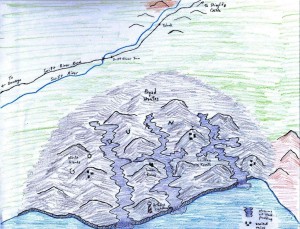 Pronounced Go-do-ann-ill, this is a region of bleak hills where the sky is always overcast, which end in cliffs that overlook the Olde Bay in the center of its north shore. In the valleys run wide streams of black pudding and other oozes, fungi and molds are common.
Pronounced Go-do-ann-ill, this is a region of bleak hills where the sky is always overcast, which end in cliffs that overlook the Olde Bay in the center of its north shore. In the valleys run wide streams of black pudding and other oozes, fungi and molds are common.
Goduanil stretches for many miles along the rocky coast and runs almost to the Swift River Road which parallels the river up onto the Cyrűk Mountains.
Locations and encounters within Goduanil include:
* Pryad Wastes
* Black Pudding Streams
* Oozes, Fungi and Molds
* Griffon Roosts
* Waste Giants
Locations of interest to the party include:
* Arthens Lighthouse
* Various ancient ruins sites
* The mysterious tower ruins where rumor has it a wizard went to hide
Posted in Region and tagged Location, Northbay, waste by Stephen Hilderbrand with no comments yet.
